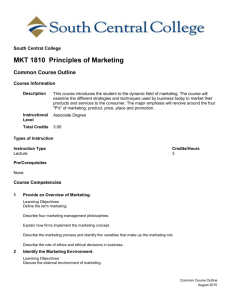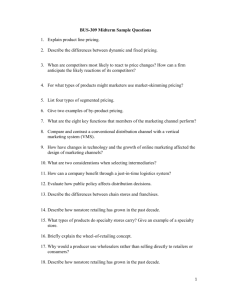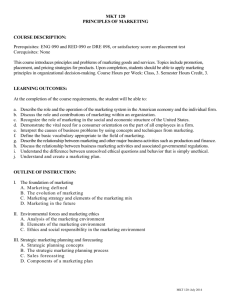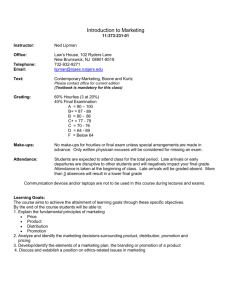bus.211.outline.f2010 - Student Learning Outcomes (SLO)
advertisement
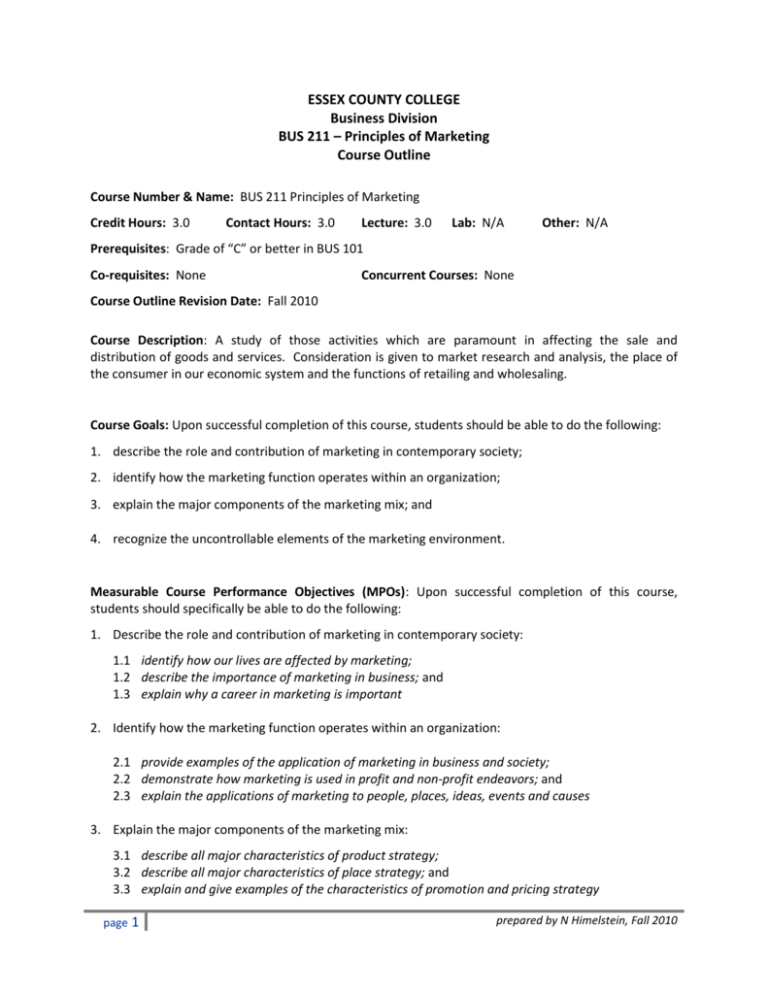
ESSEX COUNTY COLLEGE Business Division BUS 211 – Principles of Marketing Course Outline Course Number & Name: BUS 211 Principles of Marketing Credit Hours: 3.0 Contact Hours: 3.0 Lecture: 3.0 Lab: N/A Other: N/A Prerequisites: Grade of “C” or better in BUS 101 Co-requisites: None Concurrent Courses: None Course Outline Revision Date: Fall 2010 Course Description: A study of those activities which are paramount in affecting the sale and distribution of goods and services. Consideration is given to market research and analysis, the place of the consumer in our economic system and the functions of retailing and wholesaling. Course Goals: Upon successful completion of this course, students should be able to do the following: 1. describe the role and contribution of marketing in contemporary society; 2. identify how the marketing function operates within an organization; 3. explain the major components of the marketing mix; and 4. recognize the uncontrollable elements of the marketing environment. Measurable Course Performance Objectives (MPOs): Upon successful completion of this course, students should specifically be able to do the following: 1. Describe the role and contribution of marketing in contemporary society: 1.1 identify how our lives are affected by marketing; 1.2 describe the importance of marketing in business; and 1.3 explain why a career in marketing is important 2. Identify how the marketing function operates within an organization: 2.1 provide examples of the application of marketing in business and society; 2.2 demonstrate how marketing is used in profit and non-profit endeavors; and 2.3 explain the applications of marketing to people, places, ideas, events and causes 3. Explain the major components of the marketing mix: 3.1 describe all major characteristics of product strategy; 3.2 describe all major characteristics of place strategy; and 3.3 explain and give examples of the characteristics of promotion and pricing strategy page 1 prepared by N Himelstein, Fall 2010 Measurable Course Performance Objectives (MPOs) (continued): 4. Recognize the uncontrollable elements of the marketing environment: 4.1 4.2 4.3 4.4 4.5 identify all major characteristics of the competitive environment; cite some of the major laws that comprise the political and legal environment; describe the four cycles or phases of our economic environment; give examples of the use of technology in marketing; and describe three critical issues relating to marketing and society Methods of Instruction: Instruction will consist of lecture, class discussions, and case study analysis. Outcomes Assessment: Exam questions are blueprinted to course objectives. A rubric is used to assess the term projects for the performance of course objectives. Data is collected and analyzed determine the level of student performance on these assessment instruments in regards to meeting course objectives. The results of this data analysis are used to guide necessary pedagogical and /or curricular revisions. Course Requirements: All students are required to: 1. Maintain regular attendance. 2. Complete assigned homework or projects in a timely manner 3. Take part in class discussion and participate in class exercises 4. Take all exams when scheduled: these include a minimum of three hourly exams as well as a cumulative departmental final exam. Methods of Evaluation: Final course grades will be computed as follows: Grading Components Case studies and class participation % of final course grade 10 – 25% The case studies will demonstrate knowledge of concepts and topics related to marketing. Class participation will show evidence of comprehending major terms and topics as well as applications of marketing terminology. Three or more Examinations (dates specified by the instructor) 25 – 35% Tests will show evidence of the extent to which students meet course objectives including but not limited to identifying and applying concepts, understanding terms and demonstrating evidence of a basic foundation of marketing principles. page 2 prepared by N Himelstein, Fall 2010 Methods of Evaluation (continued): Grading Components % of final course grade Departmental Final Examination The comprehensive final exam will examine the extent to which students have understood and synthesized all course content and achieved all course objectives. 25 – 35% Term Project 15 – 25% Students will synthesize course material to develop an original idea and discuss the stages or steps required to bring that idea to the market. NOTE: The instructor will provide specific weights, which lie in the above-given ranges, for each of the grading components at the beginning of the semester. Academic Integrity: Dishonesty disrupts the search for truth that is inherent in the learning process and so devalues the purpose and the mission of the College. Academic dishonesty includes, but is not limited to, the following: plagiarism – the failure to acknowledge another writer’s words or ideas or to give proper credit to sources of information; cheating – knowingly obtaining or giving unauthorized information on any test/exam or any other academic assignment; interference – any interruption of the academic process that prevents others from the proper engagement in learning or teaching; and fraud – any act or instance of willful deceit or trickery. Violations of academic integrity will be dealt with by imposing appropriate sanctions. Sanctions for acts of academic dishonesty could include the resubmission of an assignment, failure of the test/exam, failure in the course, probation, suspension from the College, and even expulsion from the College. Student Code of Conduct: All students are expected to conduct themselves as responsible and considerate adults who respect the rights of others. Disruptive behavior will not be tolerated. All students are also expected to attend and be on time for all class meetings. No cell phones or similar electronic devices are permitted in class. Please refer to the Essex County College student handbook, Lifeline, for more specific information about the College’s Code of Conduct and attendance requirements. page 3 prepared by N Himelstein, Fall 2010 Course Content Outline: based on the text Contemporary Marketing, 14th edition, by Boone and Kurtz; published by CENGAGE; ISBN 13 #: 978-0-324-58203-1. Class Meeting (80 minutes) Chapter/Section CHAPTER 1 MARKETING: THE ART AND SCIENCE OF SATISFYING CUSTOMERS Review Class Syllabus What is Marketing? 1 2 Four Eras of Marketing Elements of a Marketing Strategy Extending the Traditional Boundaries of Marketing 3 CHAPTER 2 STRATEGIC PLANNING IN CONTEMPORARY MARKETING Marketing Planning: The basics for Strategy and Tactics Steps in the Marketing Planning Process Successful Strategies: Tools and Techniques Elements of a Marketing Strategy Methods for Marketing Planning 4–5 CHAPTER 3 THE MARKETING ENVIRONMENT, ETHICS, AND SOCIAL RESPONSIBILITY Environmental Scanning and Environmental Management The Competitive Environment The Political/Legal Environment The Economic Environment The Societal/Cultural Environment Prepare for Discussion Only: Video Case 3.2 The Marketing Environment: Ethics and Social Responsibility At Schofield Honda 5 CHAPTER 4 E-COMMERCE: MANAGING THE CUSTOMER EXPERIENCE The Digital World E-Commerce and E-Marketing Who Are the Online Buyers and Sellers B2B E-Marketing B2C E-Marketing Building an Effective Web Presence Prepare for Discussion Only: Video Case 4.2 E-business at EVO 6 EXAMINATION #1 on Chapters 1, 2, 3 & 4 page 4 prepared by N Himelstein, Fall 2010 Class Meeting (80 minutes) 7 Chapter/Section CHAPTER 5 CONSUMER BEHAVIOR Interpersonal Determinants of Consumer Behavior Personal Determinants of Consumer Behavior The Consumer Decision Process Prepare and Hand In: Video Case 5.2 Consumer Behavior at Schofield Honda 8 CHAPTER 6 BUSINESS-TO-BUSINESS (B2B) MARKETING The Nature of the Business Market Segmenting Business to Business Markets Characteristics of the Business to Business Market The Business Buying Process 9 CHAPTER 7 GLOBAL MARKETING The Importance of Global Marketing The International Marketing Environment Multinational Economic Integration The European Union, Its Purpose and Importance Going Global Strategies for Entering Foreign Markets 10 CHAPTER 8 MARKETING RESEARCH AND SALES FORECASTING The Market Research Function The Market Research Process Market Research Methods Computer Technology in Marketing Research Sales Forecasting Prepare for Discussion Only: Video Case 8.2 Market Research and Sales Forecasting at Ogden Publishers 11 CHAPTER 9 MARKET SEGMENTATION, TARGETING AND POSITIONING The Role of Market Segmentation Segmenting Consumer Markets The Market Segmentation Process Strategies for Reaching Target Markets 12 Examination #2 on Chapters 5, 6, 7, 8 & 9 13 CHAPTER 10 RELATIONSHIP MARKETING AND CUSTOMER RELATIONS MANAGEMENT (CRM) The Shift from Transaction-Based Marketing to Relationship Marketing The Relationship Marketing Continuum Enhancing Customer Satisfaction Customer Relationship Management page 5 prepared by N Himelstein, Fall 2010 Class Meeting (80 minutes) Chapter/Section 14 CHAPTER 11 PRODUCTS AND SERVICE STRATEGY What is A Product? What Are Goods and Services? Classifying Goods and Services for Consumer and Business Markets Quality as a Product Strategy Development of Product Lines The Product Life Cycle Extending the Product Life Cycle 15 – 16 CHAPTER 12 DEVELOPING AND MANAGING BRAND AND PRODUCT CATEGORIES Managing Brands for Competitive Advantage Product Identification New Product Planning The New Product Development Process Prepare and Hand In: Video Case 12.2 Developing and Managing Brand and Product Categories at Maine Media Workshops 17 – 18 CHAPTER 13 MARKETING CHANNELS AND SUPPLY CHAIN MANAGEMENT The Role of Marketing Channels in Marketing Strategy Types of Marketing Channels Channel Strategy Decisions Vertical Marketing Systems Physical Distribution 19 CHAPTER 14 RETAILERS, WHOLESALERS AND DIRECT MARKETERS Evolution of Retailing Retailing Strategy Types of Retailers Wholesaling Intermediaries Direct Marketing and Other Non Store Retailing Scrambled Merchandising Prepare and Hand In: Video Case 14 Retailing at Flight 001 20 EXAMINATION #3 on Chapter 10, 11, 12, 13 & 14 21 – 22 CHAPTER 15 INTEGRATED MARKETING COMMUNICATIONS The Communication Process Objectives of Promotion Sponsorships Direct Marketing Developing an Optimal Promotional Mix Pulling and Pushing Promotional Strategy Budgeting for Promotional Strategy page 6 prepared by N Himelstein, Fall 2010 Class Meeting (80 minutes) 23 – 24 Chapter/Section CHAPTER 16 ADVERTISING AND PUBLIC RELATIONS Advertising Advertising Strategies Creating an Advertisement Media Selection Public Relations TERM PROJECT DUE 25 – 26 CHAPTER 17 PERSONAL SELLING AND SALES PROMOTION The Evolution of Personal Selling The Four Sales Channels The Sales Process Managing the Sales Effort Ethical Issues in Sales Sales Promotion 27 CHAPTER 18 PRICING CONCEPTS Pricing and the Law Pricing Objectives and the Marketing Mix Methods for Determining Prices Price Determination in Economic Theory Price Determination in Practice Global issues in Price Determination 28 CHAPTER 19 PRICING STRATEGIES Pricing Strategies Price Quotations Pricing Policies Global Considerations and Online Pricing 29 Review 30 DEPARTMENTAL FINAL EXAMINATION on all course material covered page 7 prepared by N Himelstein, Fall 2010
